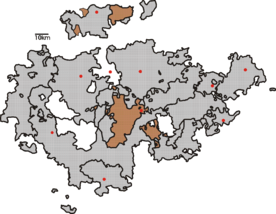Free State of Schwarzburg-Rudolstadt
| coat of arms | flag |
|---|---|

|

|
| Situation in the German Reich | |

|
|
| Arose from | Principality of Schwarzburg-Rudolstadt |
| Incorporated into | State of Thuringia |
| Data from 1919 | |
| State capital | Rudolstadt |
| Form of government | republic |
| Consist | 1918-1920 |
| surface | 941 km² |
| Residents | 97,983 inhabitants |
| Population density | 104 inhabitants / km² |
| Religions | 98.5% Ev. 1.3% Roman Catholic 0.2% others |
| Reichsrat | 1 vote |
| License Plate | SR |
| administration | 3 district offices |
| map | |

|
|
The Free State of Schwarzburg-Rudolstadt emerged from the Principality of Schwarzburg-Rudolstadt after the First World War . It existed from November 1918 until it was merged with six other free and people's states to form Thuringia on May 1, 1920.
history
On November 23, 1918, Prince Günther Victor resigned the affairs of state for the Principality of Schwarzburg-Rudolstadt after he had signed a law two days earlier with the necessary constitutional amendments. The principality had become a free state .
The last elected state parliament in 1912, in which the SPD had a majority, confirmed the three department heads and state officials of the old state government, the Minister of State Franz Freiherr von der Recke, the Privy Councilor of State Richard Werner and the Council of State Friedrich Wißmann, in their offices and on November 23 elected Emil Hartmann (SPD), Ernst Otto (SPD) as well as Albert Scholl (SPD) and Oskar Hertel (DDP) as further members of the overall ministry, with Emil Hartmann becoming chairman. On December 8, the state parliament passed a new electoral law and set March 16, 1919 as the date for the state elections.
The SPD again won an absolute majority in the state elections . The members of the government were confirmed in office on May 23, but Freiherr von der Recke did not run for office.
On the same day, the Landtag of Schwarzburg-Rudolstadt was the first Thuringian parliament to approve the merger of the Thuringian states .
With the establishment of the state of Thuringia on May 1, 1920, the Free State of Schwarzburg-Rudolstadt formally ceased to exist as a sovereign federal state. The “Law on the Administration of the Former Thuringian Lands in the Transitional Period” of December 9, 1920 finally transformed the Free State into a higher-order municipal association with regional representation and regional government, which was finally repealed on April 1, 1923.
With a law passed by Prince Günther Victor on November 22, 1918 and confirmed by the state parliament, a severance payment agreement was made on his property and financial situation. The chamber property with an area of 22,600 hectares, the coin collection in Rudolstadt and the weapons collection in the armory of Schwarzburg Castle became the property of the state. The former sovereign was awarded a lifelong annual pension of 150,000 marks and rights to use Schwarzburg Castle , Rathsfeld Hunting Lodge and some rooms in Heidecksburg . In addition, the main content of the castles became his property and he was entitled to hunting rights in the Schwarzburg Forest and fishing rights in the Schwarza .
Election to the first state parliament
- Election date: March 16, 1919
- Seats in the state parliament: 17
| Political party | Result | Seats |
|---|---|---|
| Association of farmers | 13.61% | 2 |
| DDP | 14.73% | 3 |
| DNVP and DVP | 10.75% | 1 |
| SPD | 54.10% | 11 |
| USPD | 6.81% | - |
-
State government : Head of the General Ministry Emil Hartmann (SPD),
civil servants of the General Ministry Secret State Councilor Richard Werner and State Councilor Friedrich Wißmann,
parliamentary members Ernst Otto (SPD), Albert Scholl (SPD) and Oskar Hertel (DDP) - List of members of the state parliament (Free State of Schwarzburg-Rudolstadt)
literature
- Frank Esche: State Parliament of the Free State of Schwarzburg-Rudolstadt and regional representative in Rudolstadt . In: Harald Mitteldorf (Red.): The forgotten parliaments. State parliaments and regional representations in the Thuringian states and territories 1919 to 1923 . Published by the Thuringian Parliament. Hain, Rudolstadt et al. 2002, ISBN 3-89807-038-7 ( writings on the history of parliamentarism in Thuringia 19).
